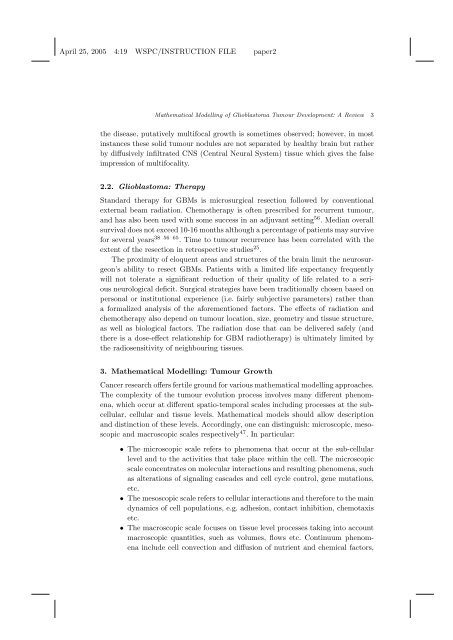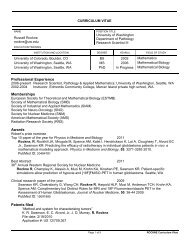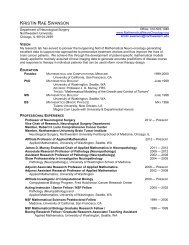April 25, 2005 4:19 WSPC/INSTRUCTION FILE paper2 ...
April 25, 2005 4:19 WSPC/INSTRUCTION FILE paper2 ...
April 25, 2005 4:19 WSPC/INSTRUCTION FILE paper2 ...
Create successful ePaper yourself
Turn your PDF publications into a flip-book with our unique Google optimized e-Paper software.
<strong>April</strong> <strong>25</strong>, <strong>2005</strong> 4:<strong>19</strong> <strong>WSPC</strong>/<strong>INSTRUCTION</strong> <strong>FILE</strong> <strong>paper2</strong><br />
Mathematical Modelling of Glioblastoma Tumour Development: A Review 3<br />
the disease, putatively multifocal growth is sometimes observed; however, in most<br />
instances these solid tumour nodules are not separated by healthy brain but rather<br />
by diffusively infiltrated CNS (Central Neural System) tissue which gives the false<br />
impression of multifocality.<br />
2.2. Glioblastoma: Therapy<br />
Standard therapy for GBMs is microsurgical resection followed by conventional<br />
external beam radiation. Chemotherapy is often prescribed for recurrent tumour,<br />
and has also been used with some success in an adjuvant setting 56 . Median overall<br />
survival does not exceed 10-16 months although a percentage of patients may survive<br />
for several years 38 56 65 . Time to tumour recurrence has been correlated with the<br />
extent of the resection in retrospective studies <strong>25</strong> .<br />
The proximity of eloquent areas and structures of the brain limit the neurosurgeon’s<br />
ability to resect GBMs. Patients with a limited life expectancy frequently<br />
will not tolerate a significant reduction of their quality of life related to a serious<br />
neurological deficit. Surgical strategies have been traditionally chosen based on<br />
personal or institutional experience (i.e. fairly subjective parameters) rather than<br />
a formalized analysis of the aforementioned factors. The effects of radiation and<br />
chemotherapy also depend on tumour location, size, geometry and tissue structure,<br />
as well as biological factors. The radiation dose that can be delivered safely (and<br />
there is a dose-effect relationship for GBM radiotherapy) is ultimately limited by<br />
the radiosensitivity of neighbouring tissues.<br />
3. Mathematical Modelling: Tumour Growth<br />
Cancer research offers fertile ground for various mathematical modelling approaches.<br />
The complexity of the tumour evolution process involves many different phenomena,<br />
which occur at different spatio-temporal scales including processes at the subcellular,<br />
cellular and tissue levels. Mathematical models should allow description<br />
and distinction of these levels. Accordingly, one can distinguish: microscopic, mesoscopic<br />
and macroscopic scales respectively 47 . In particular:<br />
• The microscopic scale refers to phenomena that occur at the sub-cellular<br />
level and to the activities that take place within the cell. The microscopic<br />
scale concentrates on molecular interactions and resulting phenomena, such<br />
as alterations of signaling cascades and cell cycle control, gene mutations,<br />
etc.<br />
• The mesoscopic scale refers to cellular interactions and therefore to the main<br />
dynamics of cell populations, e.g. adhesion, contact inhibition, chemotaxis<br />
etc.<br />
• The macroscopic scale focuses on tissue level processes taking into account<br />
macroscopic quantities, such as volumes, flows etc. Continuum phenomena<br />
include cell convection and diffusion of nutrient and chemical factors,





